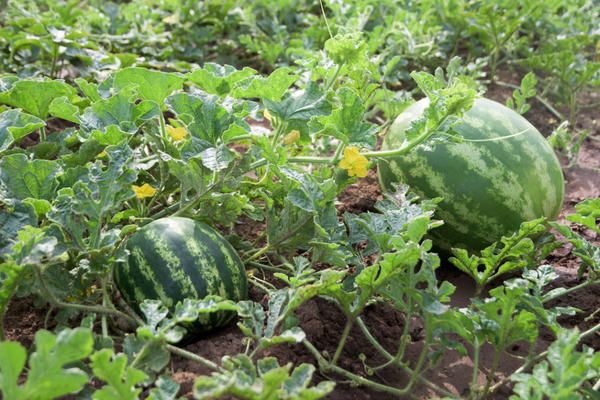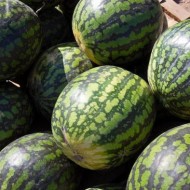Dessert variety of watermelon Holodok - the pride of Russian breeders
Content
Breeding history and growing region
Chill owes its origin to the African deserts of Namib and Kalahari. The variety was bred by the ancient Egyptians several thousand years ago.

In Russia, the fruit appeared in the eighth century AD. At first it was about the size of an orange and tasted with bitterness. But after it was domesticated, the fruit acquired a characteristic sweet taste and grew in size.
Video "Planting watermelons in a proven way"
In this video, you will learn about a proven method of planting watermelons.
Varietal characteristics of watermelon Chill
The fruit is late ripening. The growing period from the first germination to harvest is three months. It is a very powerful plant with many lashes. The length of the main whip reaches five meters. The plant has large green leaves and a wide dissected plate.
The fruit is round, slightly elongated. Their average weight is eight kilograms. The fruits are dissected with black stripes, and the flesh is bright scarlet. Watermelon Chill has a thick rind and a sweet taste. You can store it for up to six months.
The seeds are one and a half centimeters long. They are brown in color and have a rough surface.

The merits and demerits of culture
Thanks to a long list of advantages, this variety has become widespread in the post-Soviet space. These include:
- short ripening period;
- sweetness and juiciness of the pulp;
- attractive appearance;
- high level of productivity;
- long shelf life;
- ease of transportation;
- resistance to low temperatures.
Despite the long list of advantages, the variety also has disadvantages:
- watermelons need a large land area for growing;
- the fruits constantly appear side shoots, which need to be cut off regularly;
- the plant needs to provide constant warmth and light.
Planting seeds
Watermelon Chill is grown by means of seeds or seedlings. The planting is carried out in the middle of spring in specially prepared soil.
Work order
It is worth stopping your choice on planting seedlings in case of a short summer in the region. The seeds are planted in warm soil saturated with sun and air. Before planting, they need to be placed in warm water to speed up the emergence of sprouts. They need to be planted in wet sand.

Seeds germinate at temperatures from +25 ° C. When small sprouts appear, they need to be transplanted into separate small containers of two pieces. You will need 0.5 liter containers. Such containers will allow you to avoid picking.
If you are growing at home, prepare a 1: 1: 1 turf, sand and peat substrate.
Judging by the reviews, the containers need to be covered with foil and placed in a warm place to speed up the growth process. When the first shoots appear, the film can be removed.
Seedling care
In order for the watermelon to develop faster, it needs to be watered often, kept for 12 hours in the light every day, and also to carry out regular feeding. Seedlings should be watered only with settled water. When watering, make sure that moisture does not get on the leaves and stems.
When the first leaves appear on the plants, they can be fertilized with manure or a complex solution. Temper the seedlings outdoors before planting outdoors. To do this, leave the plants on the balcony for two hours, and then increase the time interval every day.
Landing in the ground
You can determine the time of planting in the soil by the number of leaves - their number should exceed 5 pieces. Find a piece of land that will be well lit by the sun. The sprouts must be protected from the wind, for this choose the southern or eastern part of the site.
Before planting Kholodok, it is advisable that legumes, cereals or cabbage grow on the land plot. It is strictly forbidden to plant watermelon seedlings in areas where zucchini, eggplants, potatoes, tomatoes and melons previously grew. Do not forget that after landing on this land plot, you cannot plant watermelons for another 6 years.
Planted watermelons should be protected from the bright sun with paper. She needs to cover the sprouts for the first few days until they gain strength. In regions with cold climates, the plant is grown in greenhouses.
Care features
This variety needs regular maintenance, so it needs to be watered and fertilized vigorously. In order to harvest a large crop, the plant must be regularly cut off from excess shoots. Leave up to four fruits on each plant. In the greenhouse, it is important to provide an air flow for the fruit.
Indoors, the culture must be tied to trellises, and the fruits are placed on stands and nets.
Watering
You need to water the fruits every week. There are three buckets of warm water per square meter. The intensity of watering depends on the outside temperature. In high heat, water the plants twice a week. Additionally, the soil is watered between the beds.
Loosening
Wet soil needs to be loosened and removed from weeds. When the plants grow, you do not need to resort to the loosening procedure. This is because gardening tools can damage delicate fruits.
Top dressing
You need to fertilize the plants twice a season: two weeks after transplanting into the soil and during the formation of buds. The first feeding should be done with nitrogen. You can use natural fertilizers like chicken manure or mullein. Fertilize the roots of the plant.
For fertilization, you can use ammonium nitrate. Dissolve 10 g of fertilizer in a bucket of water. Nitrogen fertilizers contribute to the formation of green mass, but in the future, their use must be abandoned.
Garter
When the sprouts are a little stronger, they need to be tied up. This procedure will save you time and effort. Tie the plant to a trellis at a height of half a meter from the soil. This is necessary so that each sprout receives a sufficient amount of heat and light.
In order to get large fruits, you need to regularly remove the side shoots from the tied watermelons.
Diseases and pests
This variety has medium resistance to powdery mildew and fusarium. But if you follow all the necessary growing rules, you can reduce the risk of ailments to zero. Most diseases arise from fungal infections. They appear as dark and light spots on the leaves. The fungus impairs the taste of watermelons and also causes rotting.
If the fruits grow in greenhouses, they can be infected by spider mites or melon aphids. As these pests drink the sap of the plants, the leaves will dry out and deteriorate.
It is quite easy to grow delicious Cholodok watermelons. This will require care and close attention. But by the end of the season, you can pamper yourself with delicious and juicy fruits.



